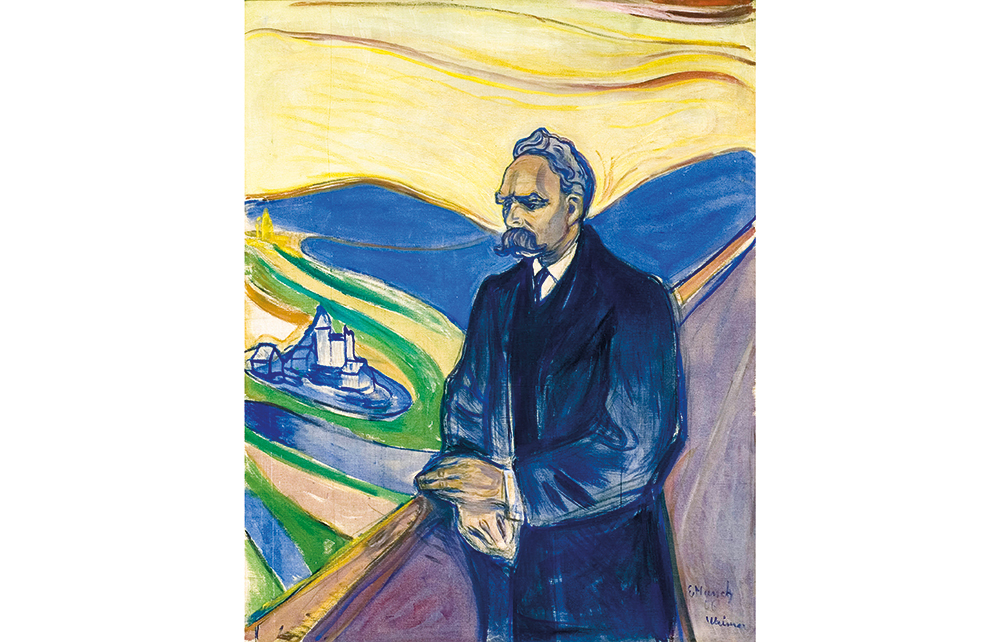For Mussolini’s 60th birthday, Hitler gave him a de luxe edition of Friedrich Nietzsche’s complete works, bound in blue pigskin. After the war, writers vied to revile the philosopher. Then, in the 1960s, he suddenly became philosophy’s darling. How come? Enter two erotically entangled Italians: Georgio Colli, a philosophy teacher at Lucca from 1942, and his pupil Mazzino Montinari, who in 1943-4 was beaten, interrogated and imprisoned for anti-fascist activism. Both found Nietzsche’s philosophy irreconcilable with fascism.
Rumours had been swirling that the Nazifying of Nietzsche emerged from the Nachlass, a mysterious hoard of Nietzsche’s manuscripts suspected to contain forgeries that were the work of his sister Elisabeth and her Nazi minions. Nietzsche loathed Elisabeth for her extreme racism and nationalism. After he went mad in 1889, Elisabeth took charge of him and his papers. Between his death in 1900 and hers in 1935, Elisabeth’s Nietzsche archive magically kept on turning out new works by her dead brother, including The Will to Power, a fascist’s Bible. Elisabeth hobnobbed with Mussolini; and Hitler even went to her funeral – unusual for him, funerals being negative publicity.
How could the two Italians prove or disprove the authenticity or inauthenticity of the post-mortem texts? Only by examining the Nachlass, rumoured to be stashed away in secret catacombs somewhere in East Germany or Russia. The Cold War was on. Joining the Communist party got Montinari into East Berlin in 1953. On he went to Weimar, home of the archive where Elisabeth had confined Nietzsche.
It turned out that the Nachlass had been there all along. Under the vigilant eye of a dedicated Stasi minder, Montinari made his home in Weimar, microfilming the Nachlass and sending the pages to Florence, where Colli prepared a transcription for publication. Visiting Weimar annually to check they were both on the same page, Colli subsisted on spaghetti brought from home, unlike Montinari, whose deep cover extended to chomping on würst.
Montinari spent years addressing the avalanche of paper, raising storms of philological dust. Nietzsche’s handwriting, hieroglyphic at the best of times, got worse towards the end of his life. It would sometimes take Montinari a day to decipher one single page. Soon he realised that his ambition to issue the texts in the order they were written was impossible, due to Nietzsche’s habit of filling his notebooks randomly from both ends.
The fact that Montinari was scrutinising the Nachlass threw philosophers into panic. Nietzsche was back on the menu. Heidegger was frantic because he had collaborated with Elisabeth on the Nachlass forgeries. Along with the German bigwigs Jaspers and Boehm, Heidegger denounced Montinari as a grave robber. Despite the GDR approving Montinari’s project, the Marxist philosopher Lukács spat venom, accusing Nietzsche of mythicising capitalist competition. The French suddenly discovered how French Nietzsche was, so un-German in his elegant aphoristic style and unbridled in his anti-German feelings. Georges Bataille, who had a sinister fixation with human sacrifice, fastened on to Nietzsche’s Dionysianism, holding saturnalia in the Bois de Boulogne and being deeply disappointed when nobody volunteered to make him the human sacrifice at the grand finale. In London, the Swinging Sixties were seen as the rebirth of Dionysus in a Nietzschean context. God is dead so let’s do the Twist.
For 35 years, Elisabeth Nietzsche magically kept turning out new works by her dead brother
This was the first wave of the Nietzschean revival and this bit of the book gets awfully bogged down in which philosopher is having coffee with who at colloques (posh word for conferences) in the 1960s and 1970s.
Montinari sneakily left the GDR in 1972. His work was not finished but he wanted to marry a woman unacceptable to the regime. His Stasi minder was deeply upset, feeling betrayed that Montinari had ‘never been open and honest with his true political disposition’. Poor Montinari, who had endured all that würst, now found himself out of step with the West. His literal word-for-word concern for philological truth, for meticulous transcription, his wrestling to establish chronology to resolve what he called ‘spatial disorder’ into ‘temporal order’ was of no interest. Truth was old hat. Interpretation was all.
Susan Sontag’s 1964 Against Interpretation had accurately described Nietzsche as being subjected to mass ravishment by an army of interpreters. Freed at last from ravishment by his sister and her Nazi friends, he was now ravished by the Postmodernists, who felt nothing but contempt for the tedious pedantry of philology which bound itself to literary truth. Derrida derided Montinari’s laborious literalness (admittedly Montinari gave him the ammo in his faithful transcriptions, which included Nietzsche’s random jottings, such as ‘I have forgotten my umbrella’). Foucault breezed along declaring that there was absolutely nothing primary to interpret, as everything Nietzsche wrote was already interpretation. The idea of an ur-text was immaterial; what mattered was hermeneutics, the theory and methodology of interpretation. It became fashionable to put the word ‘truth’ in air quotes.
Colli and Montinari withered. Colli gave TV interviews as Nietzsche’s ‘great rediscoverer’. He started composing his own Nietzschean aphorisms and eventually took to communicating in ancient Greek. He died in 1979, loathing the leftist French Nietzscheans to the end.
Montinari died in 1986. Of the 40 planned volumes, the first few had been published. They were printed in five different fonts and seven different colours. ‘Who is supposed to read these notations, and most importantly, how?’ asked a bewildered critic. What a lot of bother would have been saved if everyone had just remembered Nietzsche’s motto Mihi ipsi scripsi: I write for myself.
This should have been a great book. It’s a terrific story tediously told and chronologically muddling. Describing a character as ‘the German exchange student mentioned in the previous chapter’ should never get past an editor.






Comments